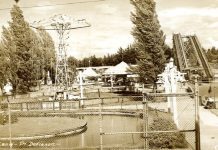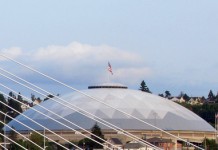You’ve heard the old adage, “Slow and steady wins the race.” Sage wisdom though it may be, Pierce Transit knows this is not the ideal way people are looking to travel when it comes to riding transit. What people want instead is reliable, fast, frequent bus service that takes them smoothly and quickly to their destination. Right now, Pierce Transit is studying the possibility of offering a new kind of bus ride that would give the people of Pierce County exactly that.
No matter how you get around—on foot, by bus, car, light rail or train—you’ve likely noticed an uptick in congestion around the South Sound. It’s not your imagination: In 2016, among the nation’s more than 3,100 counties, Pierce County saw the largest net increase of people moving in from another county within the United Stations. And, as Pierce County becomes more attractive to King County residents looking to scale back on housing costs, that growth is projected to continue at the same pace or greater into the next decade.
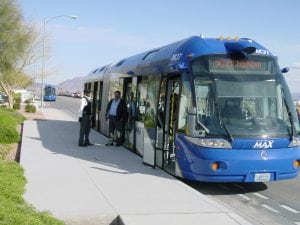
With this in mind, Pierce Transit is exploring an idea that can help accommodate Pierce County’s swelling population and alleviate some of the associated traffic congestion by giving people a new and convenient transit option: A Bus Rapid Transit line along the 14.4-mile stretch of Pacific Avenue/SR-7 between downtown Tacoma and Spanaway.
Present-Day Route 1
When Pierce Transit began evaluating areas that would be a good fit for rapid transit, this portion of Route 1 jumped out right away. Route 1, which runs from Tacoma Community College to Spanaway, is Pierce Transit’s busiest route. The portion of the route between downtown Tacoma to Spanaway sees an average of almost 3,500 bus boardings each weekday, with people traveling to work, school, appointments and other destinations.
Making improvements to this well-traveled route is a priority for Pierce Transit, and the organization is currently undergoing an in-depth study to evaluate the best options for growing this bus line. Through rigorous research and with the help of community feedback, the goal of this two-year study is to determine the feasibility of establishing a high capacity transit link in the heart of Pierce County.
Of the handful of high capacity transit options available, Pierce Transit’s Communications Manager Rebecca Japhet explains that a kind of bus service called Bus Rapid Transit (BRT) is emerging as the most popular alternative among members of the community and with those studying the feasibility of such a system. Among other benefits, BRT offers a much lower cost than other options (such as light rail) and the flexibility to make changes to the route if needed.
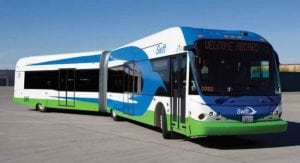
Bus Rapid Transit: Designed for a Quicker Trip
Bus Rapid Transit offers a different take on bus service that combines the speed and frequent service of light rail with the amenities usually offered on other modes, such the ability to bring bikes on board, and pay your fare before getting on board.
“Everything about Bus Rapid Transit is designed to make the trip faster,” says Japhet. “Paying the fare before getting on board means no holdup while people line up to pay their fare. Bringing bikes on board means no time waiting while loading them on the front of the bus. Level boarding between the bus and the platform means people using wheelchairs and strollers can get on easier and faster. Multiple doors mean people can get on and off more quickly. Transit signal priority means the traffic light might stay green a little longer for the bus to get through and continue down the route. And dedicated lanes along some portions of the route will mean fewer traffic delays. All these things mean BRT travel can be as fast as taking a car – without the expense and hassle of driving and parking. It can be a real game-changer in terms of the way people want to travel.”
Having a Bus Rapid Transit line would mean new stations as well, with many more amenities than a typical bus stop or shelter. New signage would deliver “real-time arrival” information letting passengers know when the next bus will arrive. Stations would be enhanced and branded, with upgraded lighting and comfortable places to wait for the bus. More frequent trips – with a bus arriving every 10 to 15 minutes during peak hours – would give passengers the ability to think less about the bus schedule and simply head to the station, knowing another bus will arrive very soon. And the vehicles themselves would have added amenities, such as Wi-Fi service.

These changes, Japhet explains, are designed to make Route 1 a more convenient, easy-to-use bus line along this important corridor. It would also provide a critical link for people who might want to connect with other transit services, for example at the Tacoma Dome Station, where they could catch Link light rail, the Sounder, Amtrak, a Sound Transit Express bus, and Intercity Transit bus, a Greyhound bus or another Pierce Transit route.
What to Expect from High Capacity Transit
As part of its two-year study, Pierce Transit looks to neighboring counties to get an idea about the impact these changes could have around the South Sound’s busiest transit route. The Vine in Vancouver, Washington, for instance, launched their BRT system in 2017. A year after it began service, riders and transit officials report a more secure, reliable and cost-effective transit experience, one that experienced a 45 percent increase in ridership and a 21 percent decrease in operating costs per passenger boarding.
Economic growth is also something other BRT routes have helped generate. Developers in Lynnwood, for example, cited Community Transit’s BRT, called the Swift Blue Line, as the biggest motivation for deciding to build a retail shopping center along that route.
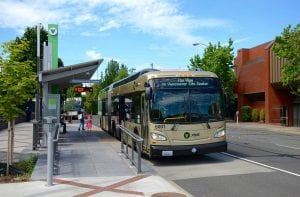
While Route 1’s feasibility study is still underway, Japhet says one of the biggest concerns that can come from this type of project are the impacts associated with construction. That’s why Pierce Transit is pleased to be working with a consulting firm that has worked on BRT systems all over the nation, and understands the importance of minimizing the impact as much as possible for drivers, businesses and others along the routes. One of the strategies employed is usually completing the work in segments, rather than working on the entire corridor all at once. There has also been concern expressed about the possibility of changing general-purpose lanes to transit-only lanes for the BRT project. Plans currently outlined in the feasibility study do not call for the removal of any general-purpose lanes along the corridor, but may include the addition of transit-only lanes, or the bus may travel in the median lane. The 14.4-mile corridor has widely-varying travel configurations, so the portion of the roadway where the bus runs would likely vary throughout the corridor.
Funding and Timing
Sound Transit 3, a measure approved by voters in November 2016, is the source of $60 million in funding for this project, with another $15 million coming in from the state. The remaining cost for the $150 million needed will most likely come in the form of federal grants, which Pierce Transit request later this year. If the Pierce Transit Board of Commissioners approve the Bus Rapid Transit project later this year and the needed federal funding is secured, work on the project could begin by 2020, with service to begin in late 2022.
It’s not too late to lend your voice to Pierce Transit’s study. The agency plans to keep the conversation going about future Route 1 developments, both in public forums and online. To stay on top of updates about this project, visit RideBRT.com or sign up for news alerts. Questions, comments or ideas for the Pierce Transit team are always welcome via email at hct@piercetransit.org.
Sponsored
























